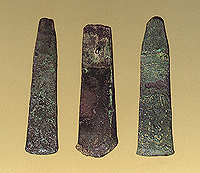The practice of metallurgy on the Aegean islands is verified by the metal artifacts made of silver, copper, gold and lead, the indispensible tools (nozzles, crucibles and moulds) and by the slags, in settlements of the Final Neolithic (4500-3200 BC) and the beginnings of the Early Bronze Age. In fact, in many settlements metal works in open or closed areas, such as Poliochni on Lesbos, Emporio on Chios and Kastri on Syros were detected. The processing of copper, silver and lead from the mines of the Cyclades (Siphnos, Kythnos), is attested on the Aegean already from the beginning of the 3rd millenium. During the same period the mixing of copper and arsenic (a metal which occurs in copper metals) is ascertained. It aims at the easier processing of copper and at the manufacture of more resistant tools. But the early presence of bronze jewellery and tools on Troy, Poliochni and Thermi does not imply that bronze metallurgy, of copper and tin was developed on these islands. According to archaeometallurgical surveys, the bronze alloy reached the islands in this form from Central Asia through Asia Minor, since sources of tin do not exist in the Aegean. The islands were occupied only with its formation into tools, etc. The knowledge of the preciousness of tin is expressed by the treasuring up of bronze tools in Thermi IVB (Potter's pool), Poliochni Red, Troy IIg and Kythnos, as well as by the presence of a tin bracelet in Thermi IIIA. The bronze alloys were promoted around the middle of the 3rd millenium from the islands of the northeastern Aegean to the Cyclades and the south Aegean. Poliochni seems to have an important role in marine trade and the promotion of the raw material and new technology. The reference to Lemnos in the legend of the expedition of the Argonauts that sailed to Colchis to get the "golden fleece" reflects nothing more than the organized sea trips to obtain precious raw materials for the practice of metallurgy. The metal objects which were manufactured on the islands during the Bronze Age comprise tools, weapons, jewellery, seals and very few vases and figurines.
|
 |
|
|
Poliochni. Copper daggers from the "treasure" of the Red period. Early Bronze Age.
|
||
 |
||
|
Naxos. Bronze chisels.
Early Cycladic II. |
||